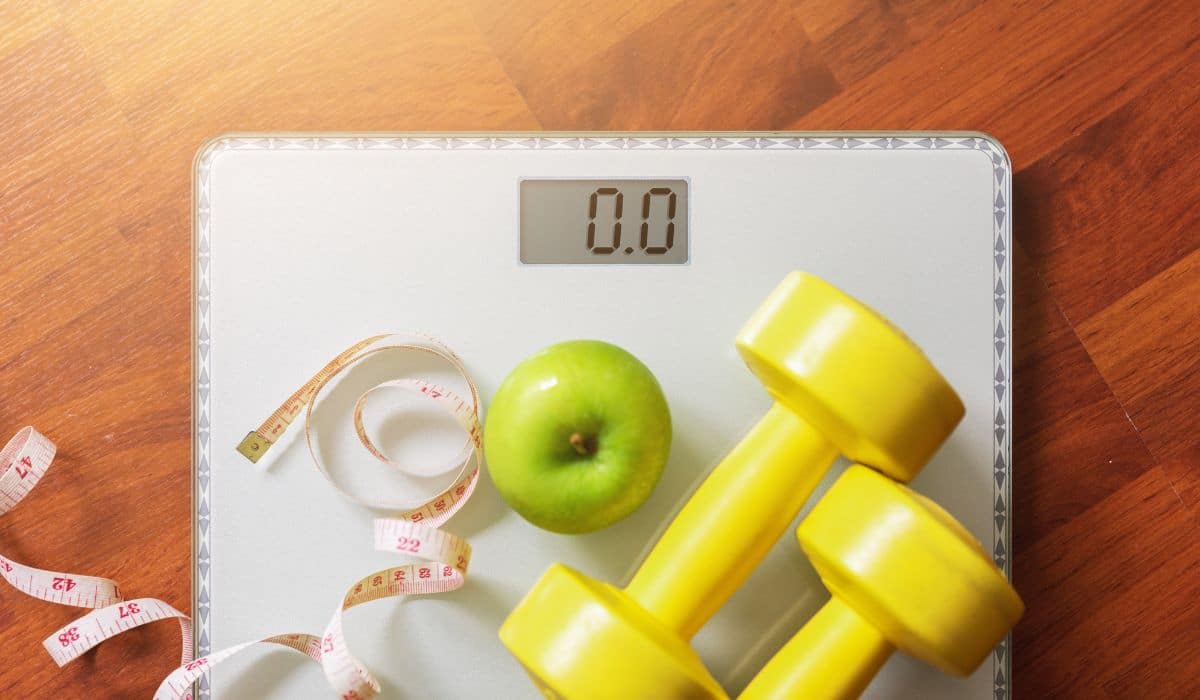
Cardio is typically praised as the king of exercises for weight loss, but there’s actually good evidence for strength training (weightlifting, powerlifting, etc.) as part of a weight loss plan if – and this is really the critical thing – you combine it with the right kind of diet.
Several studies have shown that strength training can help with sustainable and healthy weight loss. If you’re afraid that lifting weights will just make you “bulky,” take a look at the actual research before you write it off: you might be surprised!
Strength training doesn’t automatically cause weight gain.
For most people lifting weights is associated with bulkiness or gaining mass. But actually, the effects of weight training really depend on your diet:
- If you eat a calorie surplus and lift weights, you’ll gain weight overall, mostly muscle mass.
- If you eat maintenance calories and lift weights, you’ll lose a little fat and gain a little muscle, with no real change in weight overall.
- If you eat a calorie deficit and lift weights, you’ll lose weight overall, mostly from fat while preserving your muscle mass.
Think about it logically: body mass doesn’t come from nowhere. It’s not somehow magically created from thin air through the act of lifting weights. Building muscle takes a lot of additional energy (additional calories, aka additional food) on top of your body’s basic requirements for staying alive. Bodybuilders have to work really hard to get their muscles to grow that big – it takes years of disciplined training and diet. If you don’t put in that effort, you’re not going to just accidentally wake up looking like Arnold.
Want some proof? Take this study. Subjects did strength training three days a week. They all did 8 exercises: leg press, leg extension, seated leg curl, seated calf raise, incline press, compound row, triceps press, and bicep curl. Each exercise was done for 3 sets of 10 repetitions each. The subjects were split into two different diets:
- Weight loss diet: overall weight loss, mostly from fat with a little bit of muscle.
- Usual diet (whatever they were doing to maintain a stable weight before): no change in weight; subjects lost fat but gained muscle, so it evened out.
Fat mass, body fat percentage, and thigh fat decreased in both groups – even just doing resistance training with no calorie restriction reduced body fatness.
If you’re wondering what the “weight loss diet” was – we’ll get into all the details of that in a few paragraphs. But the point here is that it’s absolutely possible to combine strength training with weight loss, if you’re eating appropriately. And in fact, it has some big perks.
Resistance training actually helps with healthy and sustainable weight loss.
Unless your weight loss strategy is amputation, losing "weight" means losing either muscle or fat. Strength training makes your body keep more muscle and double down on burning your fat stores for energy instead.
For example, this study found that resistance exercise preserved muscle mass during weight loss in older adults. This study also found that resistance training maintained muscle mass in overweight adults with type 2 diabetes during weight loss.
Keeping your muscle mass has big benefits for weight loss. Muscle mass improves insulin sensitivity and metabolic health. In the long run, this makes weight loss – and maintenance, which is often even harder than the original weight loss – much easier.
Keeping muscle mass also helps prevent the metabolic slowdown that comes with weight loss. In this study, the researchers took women and put them on diets until they lost quite a bit of weight (about 26 pounds). They found that resistance training maintained muscle mass and resting energy expenditure (how many calories your body burns just from living) during weight loss.
(Also, as a side note, the first two studies above also found that strength training preserved bone health during weight loss. Weight loss can be hard on your bones, but strength training makes it easier!)
What kind of diet is best?
If the effects of resistance training depend on diet, then surely there must be some diets that are better than others. And there have actually been some studies on this as well. Take a look at three of them:

This study tried a high-protein diet (25-30% of calories from protein) combined with resistance training. The high-protein diet worked, but the subjects only kept their muscle mass if they also did resistance training. Just eating a lot of protein didn’t do much without also hitting the gym.
Carbs are another hot topic in the Paleo world – different carb levels work well for different people. This study compared a low-carb diet to a typical “healthy” diet in subjects doing strength training The low-carb diet really was low carb, with subjects restricted to just 30 grams of carbs per day. On that diet, you could have non-starchy vegetables, but not any significant amount of potatoes, bread, pasta, or anything like that. Subjects on both diets did equally well, showing that a high-carb diet isn't necessary to do well with strength training for weight loss.
This study is almost a combination of the two above. The researchers tested four different conditions:
- High-protein/low-carb diet (30% protein, 40% carb, 30% fat) with no exercise
- High-protein/low-carb diet + exercise
- High-carb/low-protein diet (15% protein, 55% carb, 30% fat) with no exercise
- High-carb/low-protein diet + exercise
The exercise was walking 5 days a week and weightlifting 2 days a week for both exercise groups. The high-protein diet dramatically outperformed the high-carb diet. In fact, the lucky high-protein subjects lost more weight and more fat, but less muscle. In the high-protein + exercise group, it was even better. The exercise reduced loss of muscle while increasing loss of body fat.
Summing it Up
Resistance training is good for health no matter what you eat. In the studies above, even when the subjects were eating a typical American diet, starting up a strength training program increased their muscle mass, reduced their body fat percentage, and generally improved their health.
For weight loss, resistance training plus an appropriate diet is a winning strategy. Eat high-quality protein at every meal, but don’t feel pressured to eat a lot of carbs if that doesn’t work for you. The diet should create a calorie deficit (for more on calories and weight loss, see here), but a higher-protein Paleo template diet does that almost automatically for most people switching from a typical American diet. So there’s no reason to actually count calories – and 10 reasons not to.
For people eating that kind of diet, resistance training helps maintain muscle mass – basically, you’ll lose more of your weight as fat, rather than muscle. It also improves insulin sensitivity and metabolic health, which makes weight loss and maintenance easier. This is important if…
- You’re interested in looking fit/"toned" and not just thin
- You want to maintain your weight loss in the long term
- You generally care about being strong and healthy
Of course, it's absolutely possible to combine strength training with cardio - you could do 2 days per week of strength training and 2 days per week of walking, running, or biking. "Strength training is helpful" doesn't mean "do only strength training" - it's just one strategy with quite a bit of evidence showing that it's helpful.





Leave a Reply